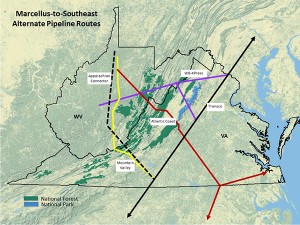
This map shows approximate routes of four proposed natural gas pipelines running through Virginia. Image credit: Dominion Pipeline Monitoring Coalition. (Click for larger image.)
by James A. Bacon
A coalition of pipeline opponents has called upon the Federal Energy Regulatory Commission (FERC) to conduct a comprehensive review of the need for four natural gas pipelines running through Virginia rather than reviewing them on their individual merits. The coalition, which includes numerous environmental and landowner groups, was joined by two Virginia state legislators: Sen. John S. Edwards, D-Roanoke, and Del. Joseph R. Yost, R-Giles.
Foes have raised a host of issues regarding the impact of the proposed pipeline projects on the environment and landowners. While the pipelines would be buried, their rights of way would be maintained clear of trees and brush, they argue, creating erosion issues, disrupting wildlife habitat, despoiling view sheds, and harming local agricultural, craft and tourism economies. Wider impacts from bolstering the consumption of natural gas would include an increase in the greenhouse gases implicated in global warming (CO2 and methane) and environmental damage caused by fracking.
Of the four pipeline projects, the Atlantic Coast Pipeline (ACP) and the Mountain Valley Pipeline (MVP) have been actively mapping of routes, and both have filed applications with FERC. Both MVP and ACP say demand for natural gas is increasing as electric utilities switch from coal to gas, and both companies have lined up customers to purchase most of the gas that would move through their pipelines. The public need, they say, is demonstrated by the fact that the pipelines have hard contractual commitments for the gas.
FERC has not accepted previous requests for comprehensive reviews, and the response of a FERC spokesperson did not suggest than any re-evaluation of its position was imminent. “The commission’s stance has been that we don’t develop infrastructure, that we process the applications that come through FERC,” spokesperson Tamara Young-Allen told the T-D.
But pipeline foes are giving it another try. The details of their arguments can be found in a letter to FERC addressing the Atlantic Coast Pipeline specifically.
Pipeline foes say FERC is required to determine whether a pipeline applicant has made efforts to minimize adverse effects upon landowners, communities, existing pipelines and their captive customers. “To demonstrate that its proposal is in the public convenience and necessity, an applicant must show public benefits that would be achieved by the project that are proportional to the project’s adverse impacts.”
The Atlantic Coast Pipeline, states the letter, does not provide any benefit that existing pipelines could not provide. Central to their argument is that new pipelines are not needed to meet the market’s growing demand for gas.
Evidence shows that significant existing pipeline capacity may be available to serve the South East and Mid-Atlantic markets. … Gas pipelines nationwide on average utilized only 54 percent of their capacity between 1998 and 2013. FERC has similarly acknowledged the underutilization of pipeline capacity and found that improved scheduling of natural gas deliveries would make “more efficient use of existing pipeline infrastructure.”
ACP would tap bountiful Marcellus shale gas deposits in West Virginia and Ohio, creating a supply alternative in Virginia and North Carolina to gas originating in the Gulf of Mexico. But foes argue that existing or already-approved pipelines to the north can move gas from Marcellus to the existing Transco superhighway pipeline, which serves Virginia markets. In the past Transco moved gas only from south to north. But by 2017 it will be able to move gas both directions, providing a way for Marcellus gas to reach Virginia markets.
Utilizing the existing infrastructure to the maximum extent possible, foes argue, would minimize the disruptive impact of building new pipelines.
For an in-depth discussion of the four Virginia pipeline projects, see “A Plethora of Pipelines.”
Update: Dominion, managing partner of the ACP, has provided a more detailed response than appeared in the T-D article: FERC will assess the cumulative effect of ACP and other proposed projects within a three-state region. ACP anticipates minimal impact due to “implementation of specialized construction techniques, the relatively short construction time frame in any one location, and carefully developed resource protection and mitigation plans.”
While critics have called for a programmatic Environmental Impact Statement — “a much broader, speculative regional analysis” — FERC has said in recent rulings and statements that an EIS would not present “a credible forward look and would therefore not be a useful tool for basic program planning.”


